Research on Estimation Method of Fuel Cell Health State Based on Lumped Parameter Model
Abstract
:1. Introduction
2. Materials and Methods
2.1. Fuel Cell Model
2.2. Unscented Kalman Filter Algorithm to Estimate the Fuel Cell State
2.2.1. Model Discretization
2.2.2. Unscented Kalman Filter Estimates the Ohmic Internal Resistance of Fuel Cells
- (1)
- Calculate sigma points, and the number of sampling points is 2n+1:where n represents the dimension of state, the represents the average value of the input variable and the represents the column of the matrix.
- (2)
- Calculate the weight of sigma points:where represents the scaling parameter, which can reduce the prediction error, and its expression is ; m represents the average; represents the covariance; represents sigma point deviation from the value of the estimated state, called the scale factor, and is in the typical range of 10−4≤ ≤ 1; represents a point distribution related to sigma, when the sigma point integration is in Gaussian distribution, where = 2 is usually selected as the best estimation result; and represents the adjustment factor, ensuring that is a semipositive definite matrix.
- (3)
- One-step prediction of sigma point set:
- (4)
- Calculate a prediction and covariance matrix of the system state quantity. Traditional Kalman filtering is to bring the state into the state equation at the last moment and calculate the state prediction only once. Unlike traditional Kalman filtering, the UKF uses a sigma point set of prediction, calculating the weighted average of the sigma point set and obtaining a one-step prediction of the system state:
- (5)
- A new set of sigma points is obtained by using the unmarked transformation again on the predicted value of the above step:
- (6)
- Bring the new sigma point set into the observation equation and get a prediction of the observation:
- (7)
- Obtain the predicted value and covariance matrix of the observational measurement by one-step weighted summation:
- (8)
- Calculate the Kalman gain matrix:
- (9)
- Calculate the status update and covariance update of the system:
3. Results
4. Conclusions
Author Contributions
Funding
Conflicts of Interest
Nomenclature
| C | Equivalent capacitance, F |
| Working temperature of PEMFC, K | |
| The partial pressure of hydrogen, bar | |
| The partial pressure of hydrogen, bar | |
| Thermodynamic electromotive force, V | |
| The activation overvoltage, V | |
| The ohmic overvoltage, V | |
| The concentration difference overvoltage, V | |
| The fuel cell current, A | |
| The oxygen concentration, mol/cm3 | |
| The activated internal resistance, Ω | |
| The impedance of PEMFC, Ω | |
| The ohmic internal resistance, Ω | |
| The thickness of the membrane, cm | |
| The area of the membrane, cm2 | |
| The resistivity of the proton exchange membrane, / | |
| The actual current density, A/cm2 | |
| The maximum current density, A/cm2 | |
| The acquisition time, s | |
| The observation noise, / | |
| The system noise, / | |
| The covariance, / |
References
- Laghrouche, S.; Liu, J.; Ahmed, F.S.; Harmouche, M.; Wack, M. Adaptive Second-Order Sliding Mode Observer-Based Fault Reconstruction for PEM Fuel Cell Air-Feed System. IEEE Trans. Control. Syst. Technol. 2015, 23, 1098–1109. [Google Scholar] [CrossRef]
- Li, Q.; Wang, T.; Dai, C.; Chen, W.; Ma, L. Power Management Strategy Based on Adaptive Droop Control for a Fuel Cell-Battery-Supercapacitor Hybrid Tramway. IEEE Trans. Veh. Technol. 2017, 67, 5658–5670. [Google Scholar] [CrossRef]
- Liu, J.; Li, Q.; Chen, W.; Cao, T. A discrete hidden Markov model fault diagnosis strategy based on K-means clustering dedicated to PEM fuel cell systems of tramways. Int. J. Hydrog. Energy 2018, 43, 12428–12441. [Google Scholar] [CrossRef]
- Jouin, M.; Gouriveau, R.; Hissel, D.; Pera, M.-C.; Zerhouni, N. Prognostics of Proton Exchange Membrane Fuel Cell stack in a particle filtering framework including characterization disturbances and voltage recovery. In Proceedings of the 2014 International Conference on Prognostics and Health Management, Cheney, WA, USA, 22–25 June 2014; pp. 1–6. [Google Scholar]
- Kimotho, J.K.; Meyer, T.; Sextro, W. PEM fuel cell prognostics using particle filter with model parameter adaptation. In Proceedings of the 2014 International IEEE Conference on Prognostics and Health Management (PHM), Cheney, WA, USA, 22–25 June 2014. [Google Scholar]
- Zhang, D.; Cadet, C.; Bérenguer, C.; Yousfi-Steiner, N. Some Improvements of Particle Filtering Based Prognosis for PEM Fuel Cells. IFAC-PapersOnLine 2016, 49, 162–167. [Google Scholar] [CrossRef]
- Zhou, D.; Wu, Y.; Gao, F.; Breaz, E.; Ravey, A.; Miraoui, A. Degradation Prediction of PEM Fuel Cell Stack Based on Multi-Physical Aging Model with Particle Filter Approach. IEEE Ind. Appl. Soc. Annu. Meet. 2016, 1–8. [Google Scholar] [CrossRef]
- Burlatsky, S.F.; Gummalla, M.; O’Neill, J.; Atrazhev, V.V.; Varyukhin, A.N.; Dmitriev, D.V.; Erikhman, N.S. A mathematical model for predicting the life of polymer electrolyte fuel cell membranes subjected to hydration cycling. J. Power Sources 2012, 215, 135–144. [Google Scholar] [CrossRef] [Green Version]
- Jin, X.; Vora, A.; Hoshing, V.; Saha, T.; Shaver, G.; García, R.E.; Wasynczuk, O.; Varigonda, S. Physically-based reduced-order capacity loss model for graphite anodes in Li-ion battery cells. J. Power Sources 2017, 342, 750–761. [Google Scholar] [CrossRef] [Green Version]
- Morando, S.; Jemei, S.; Hissel, D.; Gouriveau, R.; Zerhouni, N. Proton exchange membrane fuel cell ageing forecasting algorithm based on Echo State Network. Int. J. Hydrog. Energy 2017, 42, 1472–1480. [Google Scholar] [CrossRef]
- Ben Salah, S.; Fliss, I.; Tagina, M. Echo State Network and Particle Swarm Optimization for Prognostics of a Complex System. In Proceedings of the 2017 IEEE/ACS 14th International Conference on Computer Systems and Applications (AICCSA), Hammamet, Tunisia, 30 October–3 November 2017; pp. 1027–1034. [Google Scholar]
- Morando, S.; Jemei, S.; Gouriveau, R.; Zerhouni, N.; Hissel, D. Fuel Cells Remaining Useful Lifetime forecasting using Echo State Network. In Proceedings of the 2014 IEEE Vehicle Power and Propulsion Conference (VPPC), Coimbra, Portugal, 27–30 October 2014; pp. 1–6. [Google Scholar]
- Javed, K.; Gouriveau, R.; Zerhouni, N.; Hissel, D. Prognostics of Proton Exchange Membrane Fuel Cells stack using an ensemble of constraints based connectionist networks. J. Power Sources 2016, 324, 745–757. [Google Scholar] [CrossRef]
- Javed, K.; Gouriveau, R.; Zerhouni, N. Data-driven Prognostics of Proton Exchange Membrane Fuel Cell Stack with constraint based Summation-Wavelet Extreme Learning Machine. In Proceedings of the 6th International Conference on Fundamentals & Development of Fuel Cells, Toulouse, France, 3–5 February 2015. [Google Scholar]
- Javed, K.; Gouriveau, R.; Zerhouni, N.; Hissel, D. PEM fuel cell prognostics under variable load: A data-driven ensemble with new incremental learning. In Proceedings of the 2016 International Conference on Control, Decision and Information Technologies (CoDIT), St. Julian’s, Malta, 6–8 April 2016; pp. 252–257. [Google Scholar]
- Zhenhao, S.U.; Xiaojie, L.I.; Jin, Q.N.; Wenjie, D.U.; Ning, H.A.N. Estimation method of power battery SOC based on BP artificial neural network. Energy Storage Sci. Technol. 2019, 8, 868–873. [Google Scholar]
- Hicham, C.; Chinemerem, C.I. State of Charge and State of Health Estimation for Lithium Batteries Using Recurrent Neural Networks. IEEE Trans. Veh. Technol. 2017, 66, 8773–8783. [Google Scholar]
- Wu, Y.; Breaz, E.; Gao, F.; Paire, D.; Miraoui, A. Nonlinear Performance Degradation Prediction of Proton Exchange Membrane Fuel Cells Using Relevance Vector Machine. IEEE Trans. Energy Convers. 2016, 31, 1570–1582. [Google Scholar] [CrossRef]
- Wu, Y.; Breaz, E.; Gao, F.; Miraoui, A. A Modified Relevance Vector Machine for PEM Fuel-Cell Stack Aging Prediction. IEEE Trans. Ind. Appl. 2016, 52, 2573–2581. [Google Scholar] [CrossRef]
- Li, J.; Liu, M. State-of-charge estimation of lithium-ionbatteries using composite multi-dimensional features and aneural network. IET Power Electron. 2019, 12, 1470–1478. [Google Scholar] [CrossRef]
- Zhu, L.; Chen, J. Prognostics of PEM Fuel Cells Based on Gaussian Process State Space Models. Energy 2018, 149, 63–73. [Google Scholar] [CrossRef]
- Ko, J.; Kleint, D.J.; Fox, D.; Haehnelt, D. GP-UKF: Unscented kalman filters with Gaussian process prediction and observation models. IEEE/RSJ Int. Conf. Intell. Robot. Syst. 2007, 1901–1907. [Google Scholar] [CrossRef] [Green Version]
- Rahimi-Eichi, H.; Ojha, U.; Baronti, F.; Chow, M.-Y. Battery Management System: An Overview of Its Application in the Smart Grid and Electric Vehicles. IEEE Ind. Electron. Mag. 2013, 7, 4–16. [Google Scholar] [CrossRef]
- Restrepo, C.; Konjedic, T.; Garces, A.; Calvente, J.; Giral, R. Identification of a Proton-Exchange Membrane Fuel Cell’s Model Parameters by Means of an Evolution Strategy. IEEE Trans. Ind. Inform. 2014, 11, 548–559. [Google Scholar] [CrossRef]
- Restrepo, C.; Garcia, G.; Calvente, J.; Giral, R.; Martínez-Salamero, L. Static and Dynamic Current–Voltage Modeling of a Proton Exchange Membrane Fuel Cell Using an Input–Output Diffusive Approach. IEEE Trans. Ind. Electron. 2015, 63, 1003–1015. [Google Scholar] [CrossRef]
- Xu, L. Modeling and Simulation of Dynamic Characteristics of PEM Fuel Cells. Ph.D. Thesis, Wuhan University of Technology, Wuhan, China, 2007. [Google Scholar]
- Baolian, Y. Fuel Cell—Principle, Technology and Application; Chemical Industry Press: Beijing, China, 2003. [Google Scholar]
- O’Hayre, R.; Cha, S.; Colella, W.; Prinz, F.B. Fuel Cell Fundamentals; Electronics Industry Press: Beijing, China, 2007; pp. 28–40. [Google Scholar]
- Correa, J.; Farret, F.; Canha, L.; Simoes, M. An electrochemical-based fuel-cell model suitable for electrical engineering automation approach. IEEE Trans. Ind. Electron. 2004, 51, 1103–1112. [Google Scholar] [CrossRef]
- Mann, R.F.; Amphlett, J.C.; Hooper, M.A.; Jensen, H.M.; Peppley, B.A.; Roberge, P.R. DeveIopment and application of a generalised steady-state electrochemical model for a PEM fuel cell. J. Power Sources 2000, 86, 173–180. [Google Scholar] [CrossRef]
- Yi, W. Research on Hydrothermal Management System of Fuel Cell Power Plant and Demonstration of Energy Storage Scheme; Harbin Engineering University: Harbin, China, 2015. [Google Scholar]
- Zhan, Z.; Zhang, Y.; Xiao, J. Study on dynamic characteristics of PEMFC transmission phenomenon. J. Wuhan Univ. Technol. 2006, 28, 614–622. [Google Scholar]
- Huang, X. Kalman Filter Principle and Application; China Telecom Press: Beijing, China, 2015. [Google Scholar]
- Fu, M. Kalman Filter Theory and Its Application in Navigation System; Science Press: Beijing, China, 2003; pp. 8–102. [Google Scholar]
- Grewal, M.S.A. Kalman Filter Theory and Practice (MATLAB Edition), 4th ed.; Liu, Y., Chen, S., Xu, S., Eds.; Electronic Industry Press: Beijing, China, 2017. [Google Scholar]
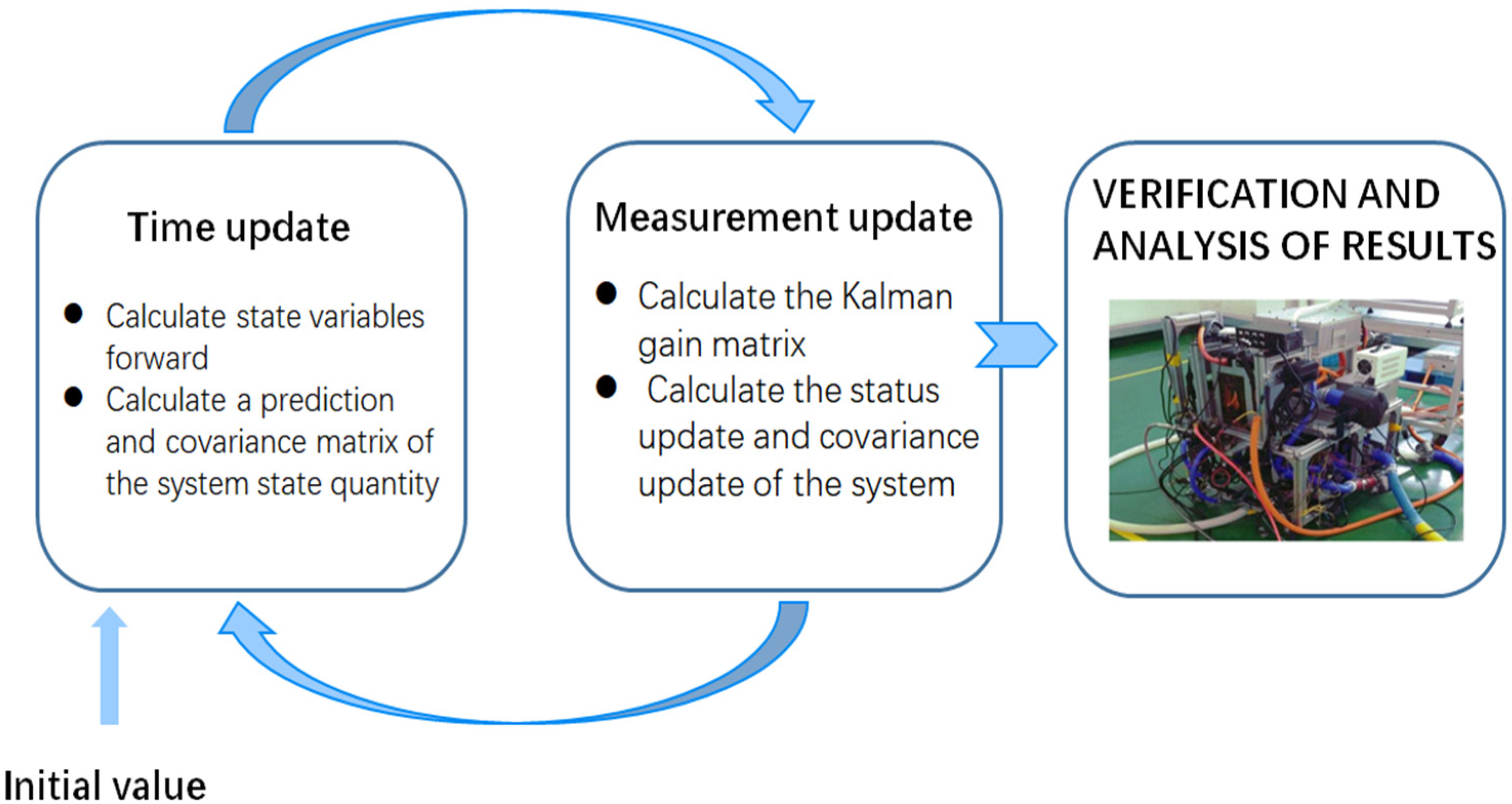

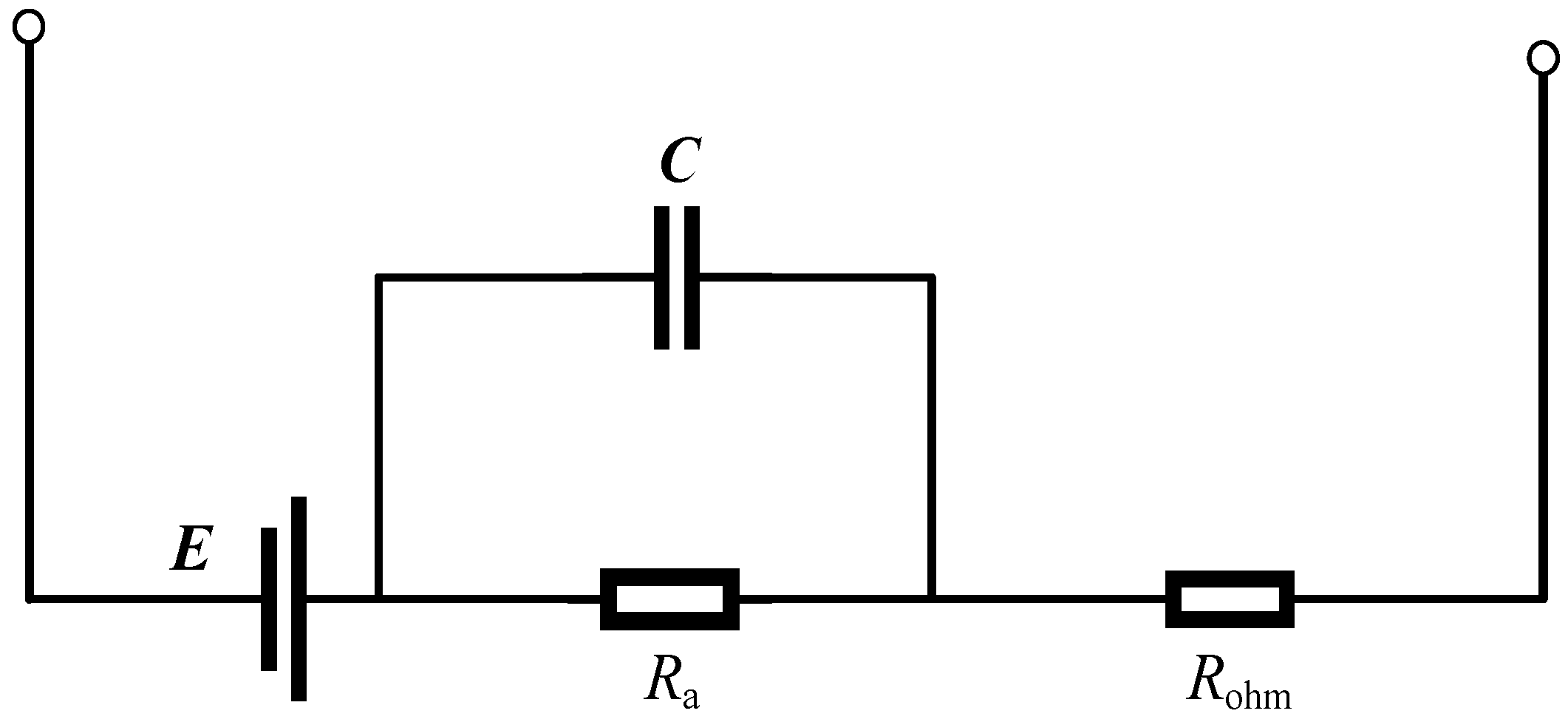
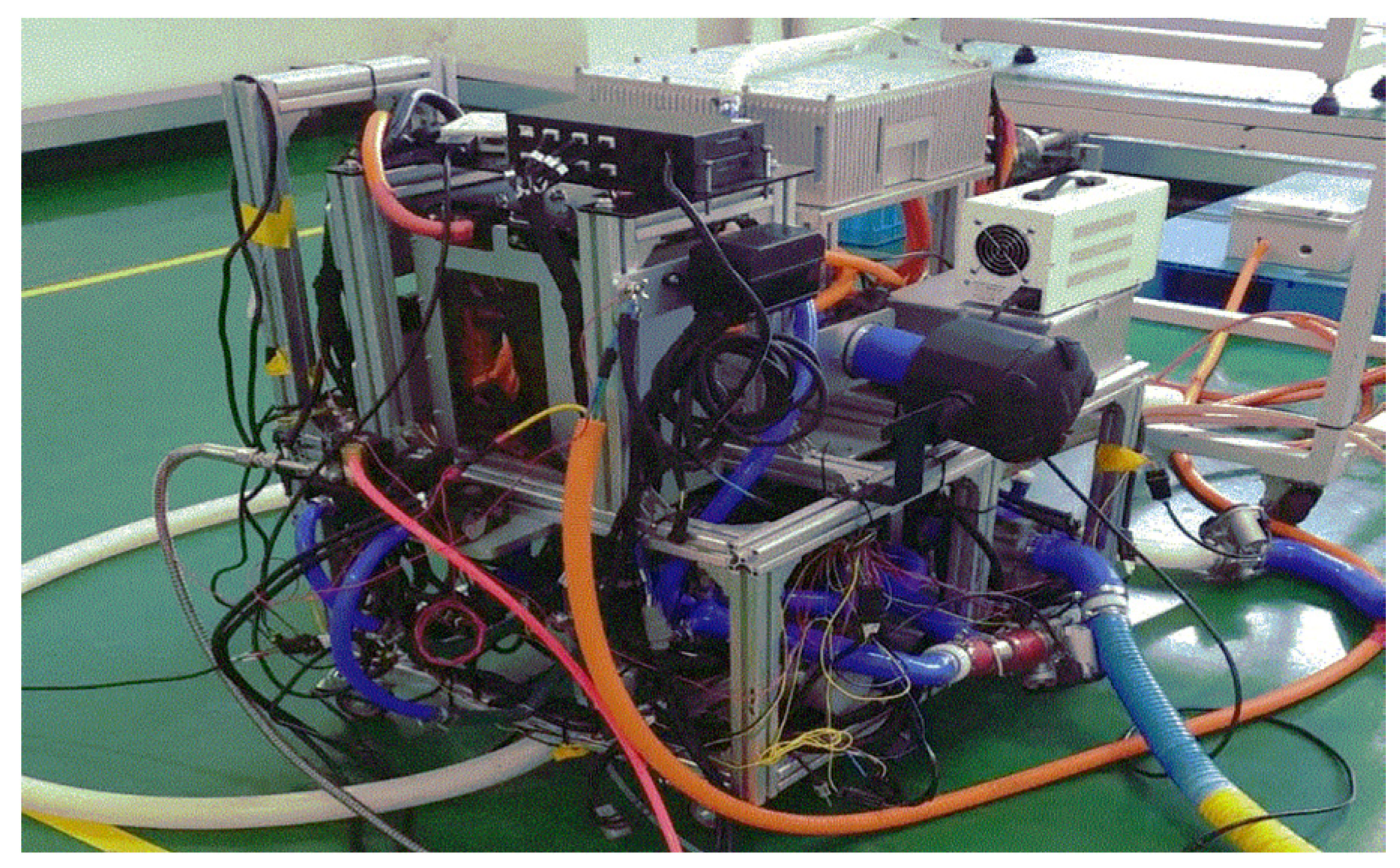
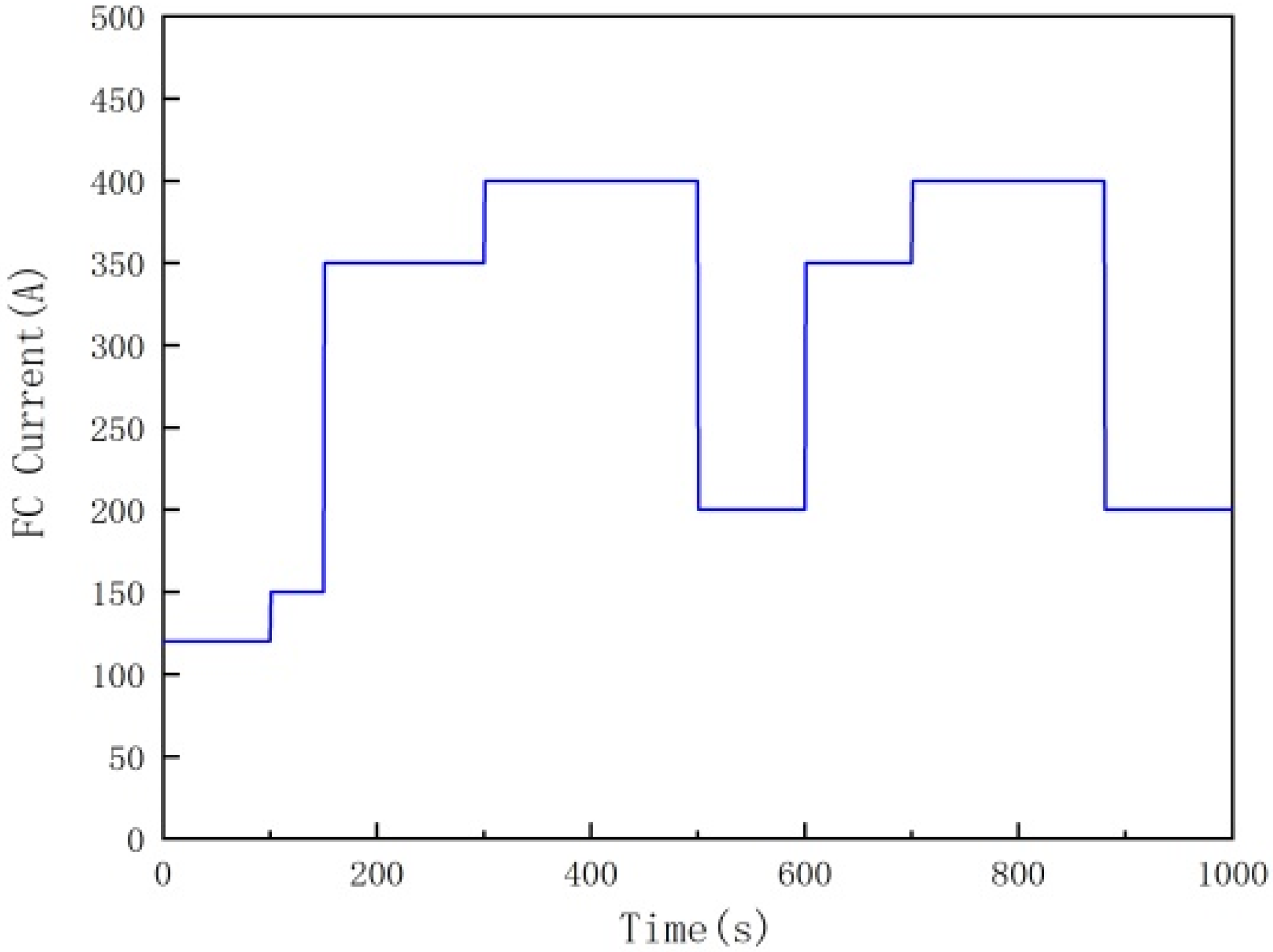
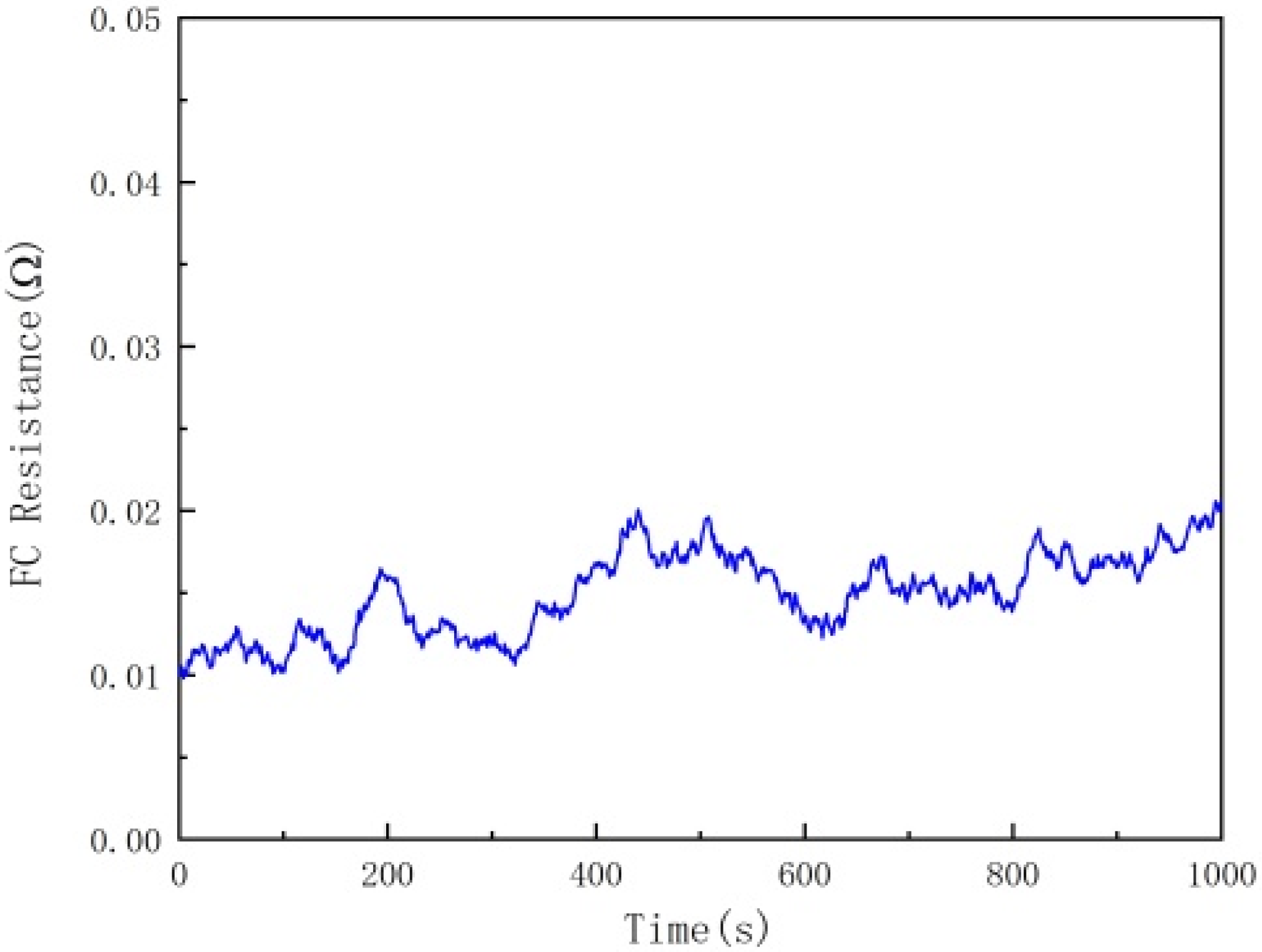
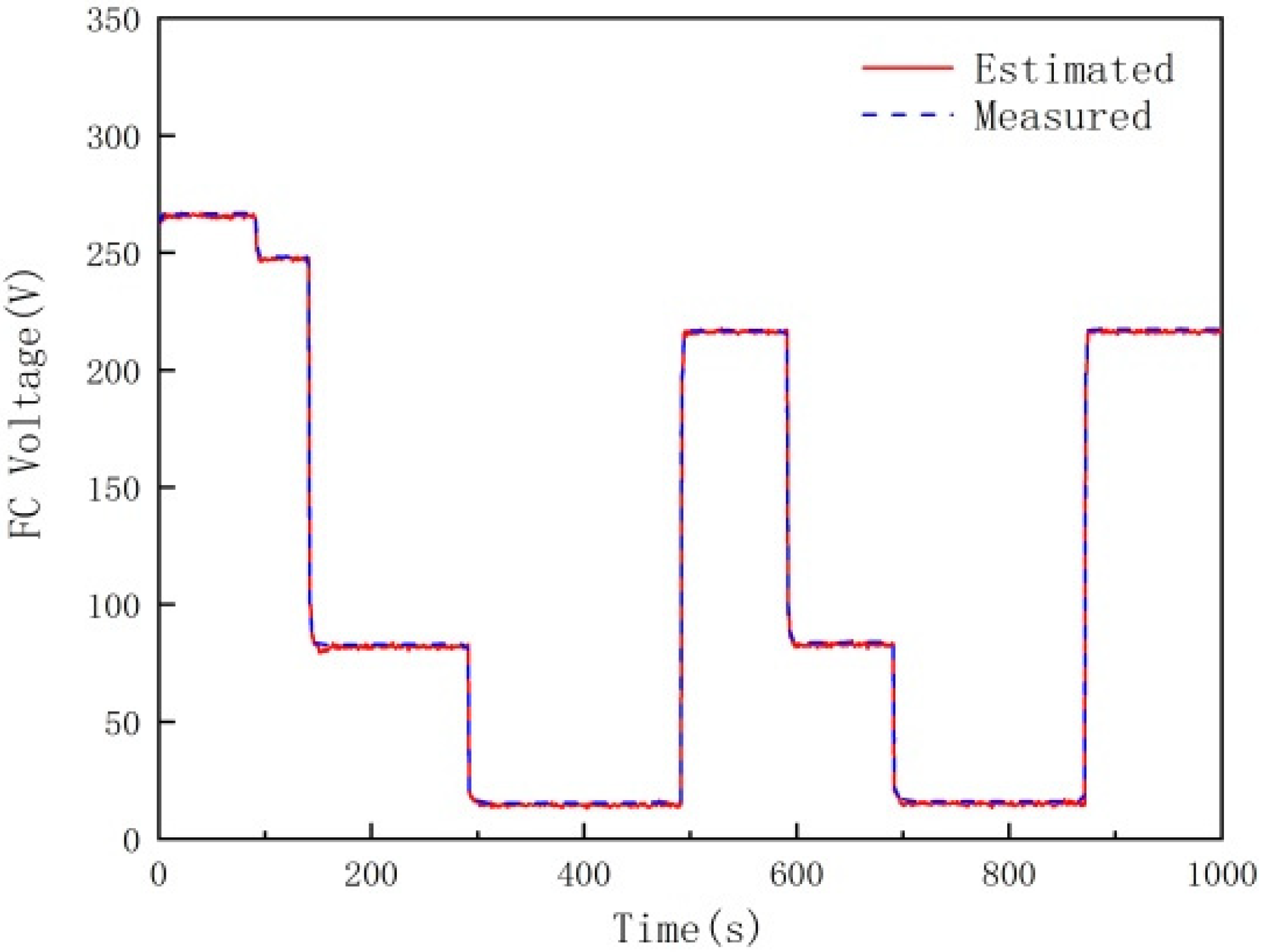

| Parameter | Value | Unit |
|---|---|---|
| T | 348.15 | K |
| C | 3 | F |
| −0.9514 | / | |
| 0.0312 | / | |
| 7.4 10−5 | / | |
| 1.87 10−4 | / | |
| 232 | cm2 | |
| 2 | A/cm2 |
| Time/s | Resistance/Ω | Rate of Change/% |
|---|---|---|
| 100 | 0.010434 | 0.000434 |
| 200 | 0.015756 | 0.005322 |
| 300 | 0.012132 | −0.003626 |
| 400 | 0.016625 | 0.004493 |
| 500 | 0.017892 | 0.001267 |
| 600 | 0.013458 | −0.004434 |
| 700 | 0.014715 | 0.001257 |
| 800 | 0.014107 | −0.000608 |
| 900 | 0.016636 | 0.002529 |
| 1000 | 0.020643 | 0.004006 |
Publisher’s Note: MDPI stays neutral with regard to jurisdictional claims in published maps and institutional affiliations. |
© 2020 by the authors. Licensee MDPI, Basel, Switzerland. This article is an open access article distributed under the terms and conditions of the Creative Commons Attribution (CC BY) license (http://creativecommons.org/licenses/by/4.0/).
Share and Cite
Ren, X.; Zhang, X.; Teng, T.; Li, C. Research on Estimation Method of Fuel Cell Health State Based on Lumped Parameter Model. Energies 2020, 13, 6425. https://doi.org/10.3390/en13236425
Ren X, Zhang X, Teng T, Li C. Research on Estimation Method of Fuel Cell Health State Based on Lumped Parameter Model. Energies. 2020; 13(23):6425. https://doi.org/10.3390/en13236425
Chicago/Turabian StyleRen, Xueshuang, Xin Zhang, Teng Teng, and Congxin Li. 2020. "Research on Estimation Method of Fuel Cell Health State Based on Lumped Parameter Model" Energies 13, no. 23: 6425. https://doi.org/10.3390/en13236425





